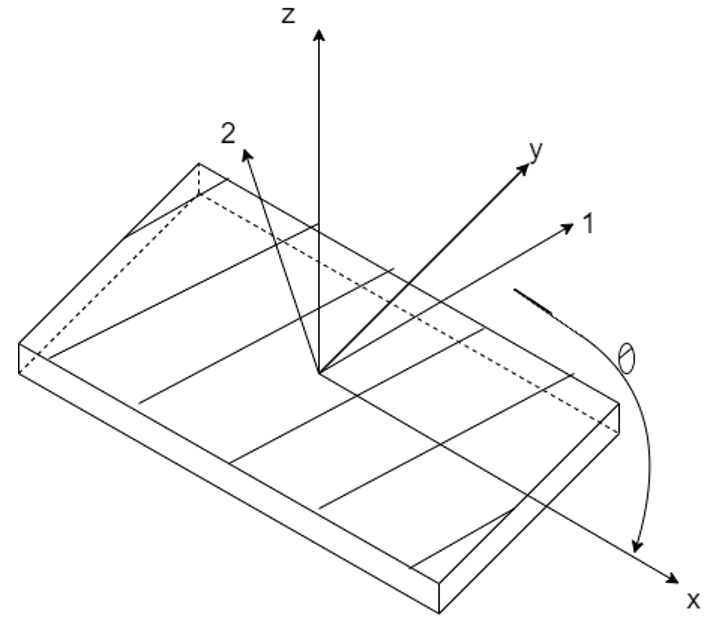This set of Composite Materials Multiple Choice Questions & Answers (MCQs) focuses on “Characteristics of a Fiber-Reinforced Lamina”.
1. What do the materials having properties the same in all directions called?
a) Orthotropic materials
b) Anisotropic material
c) Isotropic materials
d) Homogenous materials
View Answer
Explanation: Isotropic materials have identical physical properties in all the directions. The examples of isotropic materials are metals, glass, steel etc.
2. What do the materials having the properties different in all directions called?
a) Heterogeneous materials
b) Isotropic materials
c) Anisotropic materials
d) Orthotropic materials
View Answer
Explanation: The anisotropic materials have properties different in all directions so that the planes with material property symmetry do not exist in it. Composite materials and wood are some examples of such materials.
3. Orthotropic materials are a subset of anisotropic materials.
a) True
b) False
View Answer
Explanation: Orthotropic materials hold the basic property of an anisotropic material. These are the materials whose properties differ along 3 mutually orthogonal twofold axes of rotational symmetry. The fiber-reinforced composites which generally contain three orthogonal planes of material symmetry are orthotropic materials.
4. For an isotropic material, the tensile normal stress applied in any direction causes elongation in the direction of the applied stress.
a) True
b) False
View Answer
Explanation: For an isotropic material, the tensile normal stresses applied in any direction cause elongation in the direction of the applied stresses and contractions in the two transverse directions. This kind of deformation is due to the uniform properties in all directions.
5. Orthotropic and isotropic materials exhibit the same behaviour in response to normal stresses.
a) True
b) False
View Answer
Explanation: In orthotropic materials, the normal stress applied in any direction other than the principal material directions will create both shear and extensional deformations. However, when the normal stress is applied in one of the principal material directions, the orthotropic materials exhibit elongation in the direction of applied force, similar to the isotropic materials.
6. Extension-shear coupling is observed in isotropic materials.
a) True
b) False
View Answer
Explanation: Extension-shear coupling is the phenomenon of creating both shear and extensional deformations by the application of either shear stress or normal stress. The extension-shear coupling is not observed in isotropic materials. For an isotropic material, the tensile normal stresses applied in any direction cause elongation in the direction of the applied stresses and contractions in the two transverse directions.
7. What is the number of elastic independent constants in an anisotropic material?
a) 21
b) 9
c) 5
d) 2
View Answer
Explanation: The number of elastic independent constants for an anisotropic material is 21. Whereas, the number of elastic independent constants for an orthotropic material is 9, for a transversely isotropic material is 5 and for an isotropic material is 2.
8. Composite materials are typically anisotropic materials.
a) True
b) False
View Answer
Explanation: The properties of composite materials are anisotropic in nature. The anisotropic property is the reason for its high strength-to-weight ratio of composite materials. Only the load or stress carrying parts of a composite are made denser, while the other parts are made with low density so that the weight can be minimized to a good extent.
9. Which is the most critical factor in determining the strength and modulus of anisotropic materials?
a) Density of material
b) Thermal expansion coefficient
c) Direction of shear stress
d) Refractive index
View Answer
Explanation: The direction of the shear stress is a critical factor in determining the strength and modulus of anisotropic and orthotropic materials. The tensile stress is parallel to the fiber direction for a positive direction of shear which causes fiber failure. But for a negative shear, the tensile strength is perpendicular to the fiber direction which in turn leads to either a fiber-matrix interfacial failure or a matrix failure. Therefore, a positive shear is preferable over negative shear for higher load carrying conditions.
10. From this diagram of a composite lamina, identify the principal material axes of the lamina.

a) x & y
b) 1 & 2
c) 2 & y
d) 1 & x
View Answer
Explanation: The axes 1 & 2 constitute the principal material axes. Axis 1 represents the longitudinal direction and axis 2 represents the transverse direction of the lamina.
11. From this diagram of a composite lamina, identify the loading axes of the lamina.

a) 1 & x
b) 1 & 2
c) x & y
d) y & z
View Answer
Explanation: The axes x & y constitutes the loading axes of the lamina. These axes are called so because they represent the loading directions.
12. What is the angle θ in the diagram called?

a) Fiber orientation angle
b) Fiber axis angle
c) Loading axes angle
d) Principal axes angle
View Answer
Explanation: In the diagram, the angle(θ) between axes 1 & x is called the Fiber orientation angle. The sign of Fiber orientation angle depends on the right-hand coordinate system selected. The loading axis x coincides with the principal material axis 1 in a 0° lamina, whereas in a 90° lamina, the loading axis x is at a 90° angle with the principal material axis 1.
Sanfoundry Global Education & Learning Series – Composite Materials.
To practice all areas of Composite Materials, here is complete set of 1000+ Multiple Choice Questions and Answers.
If you find a mistake in question / option / answer, kindly take a screenshot and email to [email protected]
